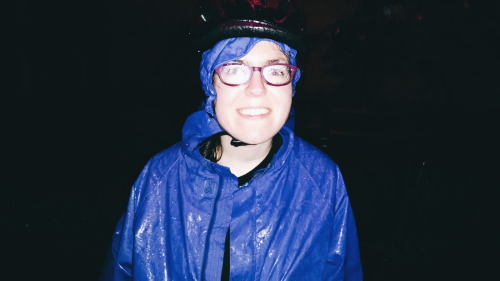#el nino
Waves of dead sea animals - whales, salmon, sardines, and clams - have been piling up on Chile’s Pacific beaches over the last few weeks. What’s going on?
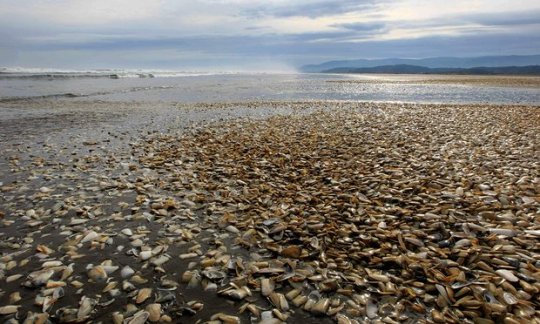
(Miles of dead clams were found on the beaches of southern Chile. Photo by Alvaro Vidal/AFP/Getty Images)
Last year, scientists could not explain why close to 300 whales turned up dead on remote bays of the southern coast of the country.
In March of 2016, the country faced a huge algal bloom which strongly impacted the salmon farming industry. This surge in algaekilled an estimated 40,000 tons of salmon in the Los Lagos region — equal to about 12% of Chile’s annual production and enough to fill 14 Olympic-sized pools. Thousands of tons of dead salmon ended up being dumped in the sea 80 miles offshore.
This month, about 8,000 tons of sardines washed up at the mouth of the central Queule River while thousands of dead clams piled up on the coast of Chiloé Island. On Santa Maria Island, cuttlefish have washed up dead in the thousands.
The authorities are putting the blame on the red tide, and have banned fishing in the affected regions, putting thousands of fishermen out of work.
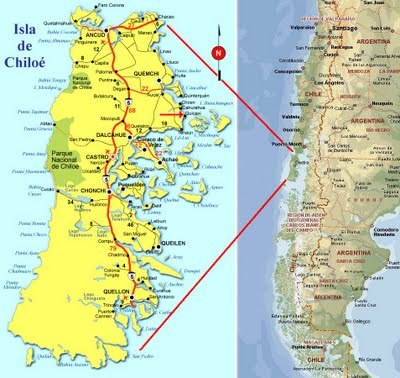
(Details and location of Chiloé Island, in Chile. Map source)
Ared tide is a harmful algal bloom which like its name indicates turns the water red, while potentially producing an elevated concentration of toxins.
It is a common and naturally recurring phenomenon in the waters of Chile, but scientists estimate that this current outbreak is unprecedented, extending further north than usual. Many point to an unusually strong El Niño weather pattern this year as a key factor.
El Niño is a disruptive weather phenomenon that comes with warming sea surface temperatures in the equatorial Pacific. Warmer waters can lead to greater quantities of algae, which kills others species by consuming oxygen in the water or filling it with toxins.
The red tide makes the mussels, clams, and other fish essentially poisonous, and thus is heavily influencing the local economies and livelihood of thousands. Fishermen around the island of Chiloé are now protesting and accusing the government of failing to alleviate the economic losses they have suffered.
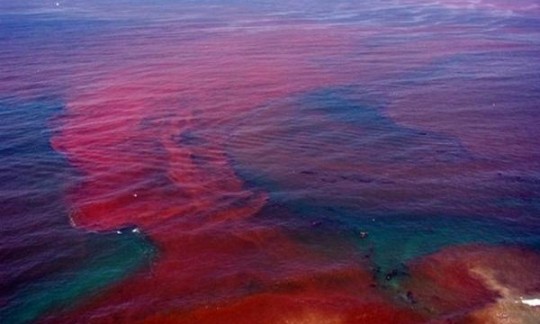
(Red tide seen from above. Photo source.)
“We think that a common factor in the deaths of creatures in southern Chile, in the salmon farms and in fish off the coast is the El Niño phenomenon,” the Chilean fisheries institute IFOP said in a statement to AFP.
While the government is quick to put the blame on the red tide and El Niño, scientists suspect there may be other factors in play. Warmer waters from El Niño do foster ideal conditions for algae to grow, but a significant nutrient input can also help trigger the bloom.
Laura Farias, an oceanographer at Chile’s Concepcion University, suggested in an interview thatthe growth of fish farming in Chile’s southern Patagonia region could be to criticize for killing the salmon and clams.
“There are studies indicating that in Patagonia the greater occurrence of toxic blooms could be a consequence of aquaculture,” she said.
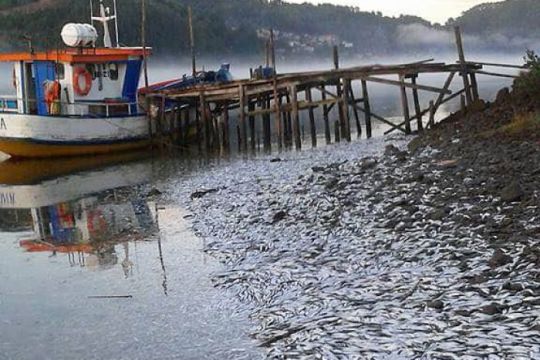
(8,000 tons of sardines were washed up at the mouth of the Queule river. Photo found on Facebook: Armada de Chile)
Incidentally,artisanal fishing unions are attributing the size of this year’s red tide on pollution by the farmed salmon industry. Chiloé residents blame the salmon industry and the government for the contamination, alleging that this oversized red tide began just after 4,000 tons of dead salmon were dumped 80 miles offshore from the island.
Other disagree, and argue the dumping of the salmon has no correlation:
“The bloom of algae is linked to the change in ocean conditions fostered by El Niño. The relationship to the dumping of the salmon has no scientific basis,”explained Universidad de Concepcion agricultural researcher Renato Quiñones.
While no scientific data is available yet, it is probably a combination of natural reasons (El Niño weather pattern, seasonal algal bloom) aggravated by unnatural causes (fish farming run-off and pollution) that is resulting in the overwhelming and heartbreaking die-off of the local marine wildlife.
tonight i heard the song i could never figure out the name of emanating from CREAM when i biked by in the rain.
Post link
This June 19, 2015 aerial photo shows a white heron taking flight over revealed fish nests, normally inches below the waterline in the La Plata reservoir in Toa Alta, Puerto Rico. Thanks to El Nino, a warming of the tropical Pacific Ocean that affects global weather, less rain fell to help refill the reservoir, as well as the La Plata river in the central island community of Naranjito.
The El Niño is expected to bring another warm, dry winter to southern B.C., and experts are watching to see how it combines with a warm-water phenomenon called “the blob” already being observed off the coast of the Pacific North West.
“This is where it starts to sound really science fiction, but how these two worlds are coming together … we haven’t seen anything like this before,” said Peter Chandler, an oceanographer with the Department of Fisheries and Oceans on Vancouver Island.
Photo: Ricardo Arduengo/AP Images
Post link

